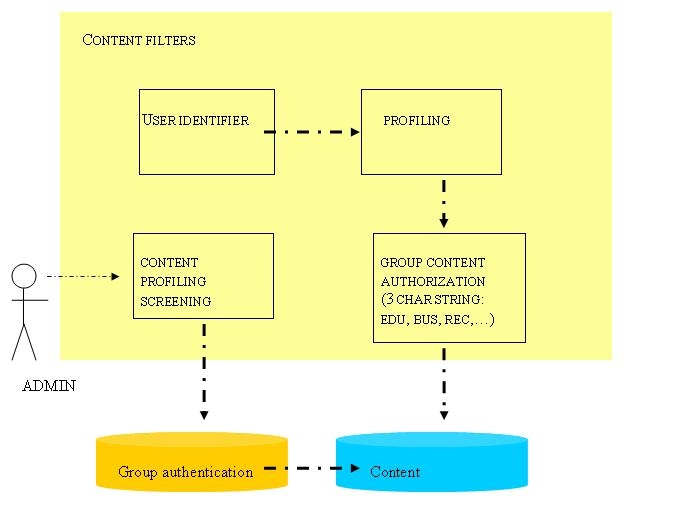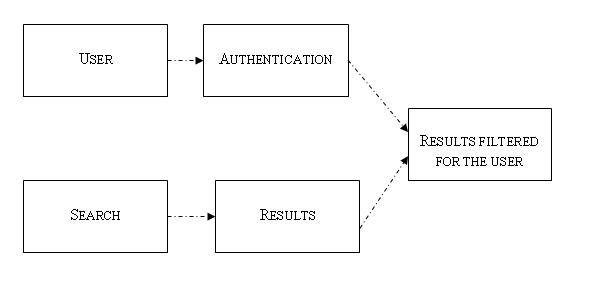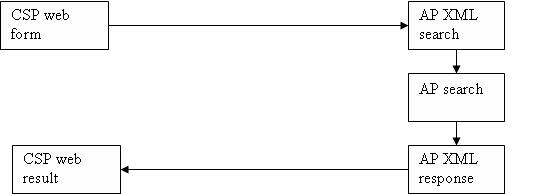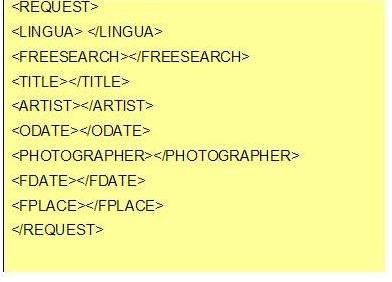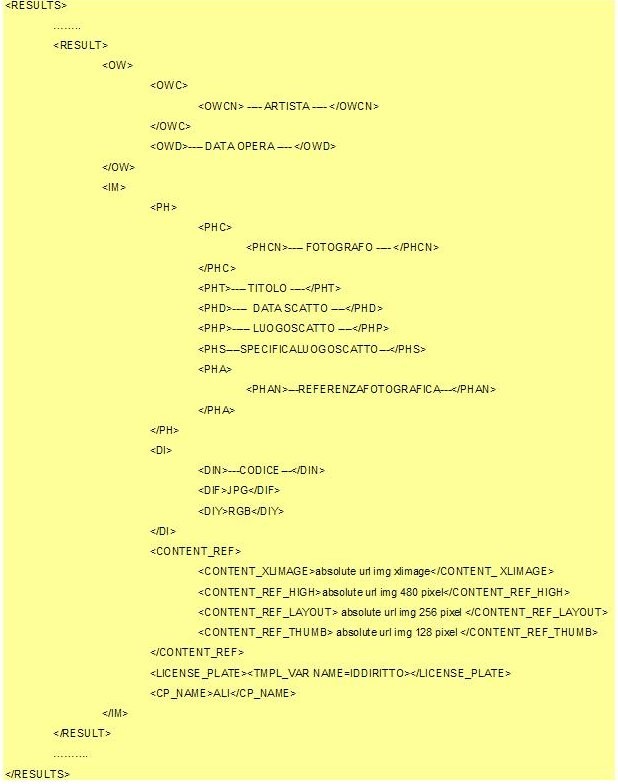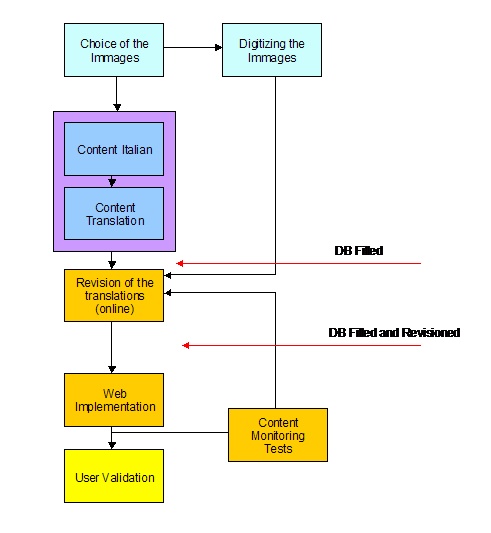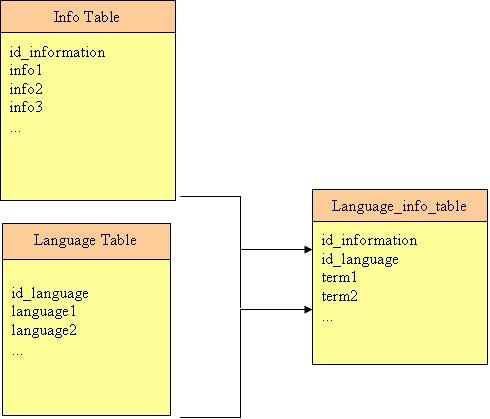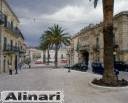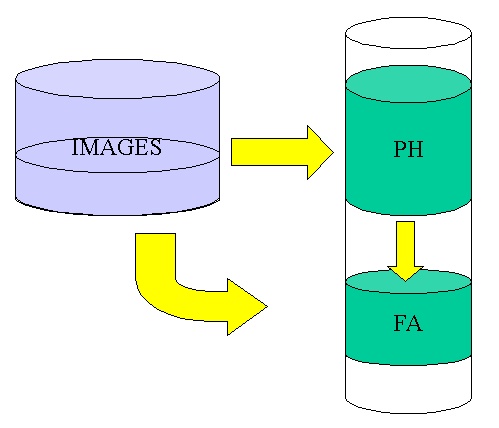D5.1orig-Appendix C - Content Filters
| Warning: this is a copy of the D5.1 document as originally submitted to the EC.
To contribute please use: Appendix C - Content Filters. |
Back to D5.1orig System Specification
The content based analysis can be realized by means of an user identification profile and the consequent user search results filtering. The management of the user profiles is done by an administrator who generates profile ruling and monitors the user activity. The profiles are mapped to content accessibility (see the figures below).
Content based management module
User Identifier: the user identifier module allows to the user the generation of his profile. The profiles are limited to the combination of specific features as: content navigation, credits, copyright.
Profiling: this module contains the available profiles to which the user can submit or subscribe. The profiles are fixed on the basis of the user context (flat rate subscription, full subscription, etc.). The profile is used to filter the content that can be navigated by the user.
Content profiling screening: this module is managed by the administrator who is in charge to profile the content. The administrator assigns the profile features to each content item. The edu -users will access the educational contents and the business-users will access the business contents. The database he manages is called ’group authentication’.
Group content authorization: on the basis of the profile, the user will be allowed to access a business area or an educational area (in practice this will imply a completely different context for the user).
Both the content and the users are profiled. The matching table will map the users and the contents on the basis of the profile characteristics.
| ID profile | ID content |
| edu | 1 |
| bus | 1 |
| bus | 2 |
Table model for mapping the user-profile and the content-profile
Contents
Search engine[edit]
The AP XML search may use the following model:
URL: http://resource complete url.cgi
METHOD: POST
PARAMETRO xml
Where the parameter xml is a string containing an xml such as:
with:
LINGUA: language selector, mandatory field, values IT or EN
The previous request will generate on the AP a response in XML containing all the information needed to edit the page to the user. In particular we’ll have an AP response as follows:
The TAG RESULT is a repeating tag as appeares once for each result found.
Organisation of the thesauruses and search modes
ICONOGRAPHIC THESAURUS: a dictionary of selected terms which allows a search via subject, ordered in 61 iconographic classes from Agriculture to Zoology.
GEOGRAPHICAL THESAURUS: functional in the search for sites. For Italy the thesaurus allows interrogation by region, province, municipality. For other countries the search can be by nation.
THESAURUS OF PERIODS AND STYLES regards interrogations involving pictures of art and allows for a search by art style and/or historical period.
THESAURUS TYPE OF WORK OF ART offers a subdivision of subjects of artistic and historical-artistic importance and therefore allows for a search by type of object and/or architectural complex.
Free text search
It lets the user to query the system by means of one or more key terms. The key words can be combined using Boolean operators (and, or, near, no, nor,…).
Analytic
The analytic search is divided into two sections: works of art (in which crossed searches can be carried out regarding the subjects depicted in art); photographs (in which crossed searches can be carried out for ’real’ subjects depicted photographically; in addition the search can also be conducted via photographic techniques).
Advanced (Fine Arts search)
The user can make any advanced cross-search referring to subjects represented in works of art. Specific searches can be carried out crossing more than one parameter, directly typing in the terms in the various fields or selecting headings from the lists.
The result of interrogation of the "advanced search for works of art" provides only subjects shown in art. For subjects regarding architecture use the "Type of Work" field instead of the "Key word" field (for example terms such as capital, dome, column… are to be looked for in the Type of work field).
A list of type of works should help the user to refine the query.
Advanced (Photography)
The user can make any advanced cross-search referring to real subjects represented in works of photography. Specific searches can also be carried out, crossing more than one parameter, directly inserting terms in the various fields or selecting headings from the lists.
The results of interrogation of the "advanced photographic search" provide only ’real’ subjects as photographed, including subjects relating to architecture. The search can also be carried out via photographic techniques.
Search by list
ARTISTS and PHOTOGRAPHERS
The artists who made the history of art and the great nineteenth- and twentieth-century.
PERSONAGES
The faces, deeds, depictions, portraits and self-portraits of personalities in the fields of culture, history, religion, the imaginary: soldiers of fortune, rulers, statesmen, aristocrats, artists, personages in the world of entertainment, leading figures and personages in the world of literature, personalities in the world of science, athletes and figures in the world of sport, saints, mythological figures...
EVENTS
The great wars, the forgotten wars, natural catastrophes, literary awards, festivals and episodes in the world of entertainment, milestones in history and in the history of science.
PHOTOGRAPHIC MOVEMENTS AND SCHOOLS
The most significant currents and movements which have characterised the stylistic and figural itinerary of the international historical-photographic panorama.
Thesaurus mode[edit]
ICHONOGRAPHIC
This thesaurus is a dictionary of controlled terms where the user can make search by subject. It is ordered into 61 iconographic classes going from Agriculture up to Zoology. The query output will give both real and art-represented subjects.
GEOGRAPHIC
The geographic thesaurus lets a search of Regions, Provinces and towns, if referred to Italy. Otherwise the search is possible using National names. The query output will give both real and art-represented places. The tree starts from the continents then it goes to the nations of the selected continent.
PERIOD AND STYLE
This thesaurus lets you search for works of art by historical period and/or artistic style. The four principal sections that can be navigated range from prehistoric art to the present.
Executive Summary Flow Diagram[edit]
Executive Summary Flow.The main steps are represented. A specific Data Base’s Tables structure
Here are reported the main technical characteristics of the database architecture.
The database has been designed in order to guarantee a multilingual management of data. The core information must be language independent, or better translation independent. In fact the main goal is to make the translation be a communication system of the information, so the information delivery will need only translation. Somehow it will similar to change the cloth but not the body nor the structure.
The following three tables should illustrate the idea.
Definition of input forms[edit]
The set of images can be divided in two great categories: reproductions of works of art (FA-form as Fine Art form) and generic photography (PH-form as photographic form). The input form to be used are different for the two categories.
PH-form: each image catalogued has an FA-form filled or partially filled. The archivist inserts into them information referring to the photographic Image:D51_ Author, Material (film, paper print, vintage print,…), Size, short content Description.
FA-form: the image is a reproduction of some work of art. In this specific case the previously filled PH-form must be linked to one or more FA-forms containing information also on the work of art itself: Author of the work of art, Place, Date of the work of art,…).
It’s clear that for each photography there must exist one only PH-form, but maybe many FA-forms (when in the same photo many pieces of work of art are represented).
Examples for the forms:
The two forms listed down here have few fields: the real forms have many other information both content information (Size of the print, …) and administrative (who inserted data, who made corrections, who made the translations,…).
Back to D5.1orig System Specification

